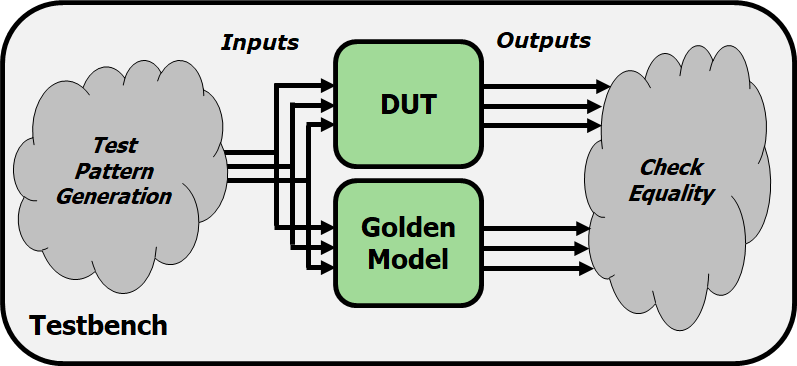Timing and verification
-
source (Design of Digital Circuits lecture 8 ETH Zürich, Spring 2019)
Golden model
- A golden model represents the ideal circuit behavior
- Must be developed, and might be difficult to write
- Can be done in C, Perl, Python, Matlab or even in Verilog
- Simpler than gate-level description
- Golden model is usually easier to design and understand
- Golden model is much easier to verify
Automatic Testbench
- The DUT output is compared against the golden model

Challenge need to generate inputs to the designs
- Sequential values to cover the entire input space —> TEST COVERAGE
- Random values –> cannot cover all possible cases, generate a test pattern to cover almost all cases
module testbench1();
... // variable declarations, clock, etc.
// instantiate device under test
sillyfunction dut (a, b, c, y_dut);
golden_model gold (a, b, c, y_gold);
// instantiate test pattern generator
test_pattern_generator tgen (a, b, c, clk);
// check if y_dut is ever not equal to y_gold
always @(negedge clk)
begin
if(y_dut !== y_gold)
$display(...)
end
endmodule
Pros:
- Output checking is fully automated
- Could even compare timing using a golden timing model
- Highly scalable to as much simulation time as is feasible
- Leads to high coverage of the input space
- Better separation of roles
- Separate designers can work on the DUT and the golden model
- DUT testing engineer can focus on important test cases instead of output checking
Cons:
- Creating a correct golden model may be (very) difficult
- Coming up with good testing inputs may be difficult
Notes
- Brute force testing is not feasible for most circuits!
- Need to prune the overall testing space
- E.g., formal verification methods, choosing ‘important cases’
Timing verification
High-level simulation (e.g., C, Verilog)
- Can model timing using “#x” statements in the DUT
- Useful for hierarchical modeling
- Insert delays in FF’s, basic gates, memories, etc.
- High level design will have some notion of timing
- Usually not as accurate as real circuit timing
Circuit-level timing verification
- Need to first synthesize your design to actual circuits
- No one general approach- very design flow specific
- Your FPGA/ASIC/etc. technology has special tool(s) for this
- E.g., Xilinx Vivado (what you’re using in lab)
- E.g., Synopsys/Cadence Tools (for VLSI design)
The Good News
- Tools will try to meet timing for you!
- Setup times, hold times
- Clock skews
- They usually provide a ‘timing report’ or ‘timing summary’
- Worst-case delay paths
- Maximum operation frequency
- Any timing errors that were found
The Bad News
- The tool can fail to find a solution
- Desired clock frequency is too aggressive
- Can result in setup time violation on a particularly long path
- Too much logic on clock paths
- Introduces excessive clock skew
-
Timing issues with asynchronous logic
- The tool will provide (hopefully) helpful errors
- Reports will contain paths that failed to meet timing
- Gives a place from where to start debugging
How can we fix timing errors?
- Unfortunately, this is often a manual, iterative process
- Meeting strict timing constraints (e.g., high performance designs) can be tedious
- try synthesis/place-and-route with different options
- Different random seeds
- Manually provided hints for place-and-route
- Manually optimize the reported problem paths
- Simplify complicated logic
- Split up long combinational logic paths
- Recall: fix hold time violations by adding more logic!
Meeting Timing Constraints: Principles
- Let’s go back to the fundamentals
- Clock cycle time is determine by the maximum logic delay we can accommodate without violating timing constraints
- Good design principles
- Critical path design: Minimize the maximum logic delay
- Maximizes performance
- Balanced design: Balance maximum logic delays across different parts of a system (i.e., between different pairs of flip flops)
- No bottlenecks + minimizes wasted time
- Bread and butter design: Optimize for the common case, but make sure non-common-cases do not overwhelm the design
- Maximizes performance for realistic cases
Summary
- Timing in combinational circuits
- Propagation delay and contamination delay
- Glitches
- Timing in sequential circuits
- Setup time and hold time
- Determining how fast a circuit can operate
- Circuit Verification
- How to make sure a circuit works correctly
- Functional verification
- Timing verification